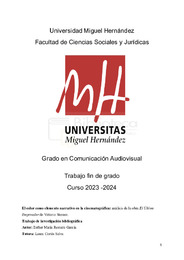Please use this identifier to cite or link to this item:
https://hdl.handle.net/11000/35537Full metadata record
| DC Field | Value | Language |
|---|---|---|
| dc.contributor.advisor | CORTÉS-SELVA, LAURA | - |
| dc.contributor.author | Romero García, Esther María | - |
| dc.contributor.other | Departamentos de la UMH::Ciencias Sociales y Humanas | es_ES |
| dc.date.accessioned | 2025-02-05T11:03:27Z | - |
| dc.date.available | 2025-02-05T11:03:27Z | - |
| dc.date.created | 2024 | - |
| dc.identifier.uri | https://hdl.handle.net/11000/35537 | - |
| dc.description.abstract | En este proyecto de investigación se pretende analizar cómo el director de fotografía Vittorio Storaro, uno de los directores de fotografía de mayor renombre, utiliza la luz y el color para aportar a la narración principal, galardonado con varios premios por su trabajo. Para ello, se explicará la función que desempeñan los directores de fotografía en la industria cinematográfica, así como las herramientas técnico-expresivas que se utilizan. Para profundizar, se revisarán brevemente los aspectos más relevantes de la vida de Storaro, así como destacar sus características como director de fotografía. Además, se va a realizar un viaje por estudio de parámetros como el color, su labor como elemento narrativo y su relación con la luz. Seguidamente, se realizará un análisis de la obra El Último Emperador (Bertolucci, 1987), reconocida y galardonada por su trabajo en este ámbito en la que, con una metodología que combina la aproximación cualitativa y cuantitativa se observarán las variables técnicas utilizadas por los directores de fotografía (luz y color). | es_ES |
| dc.description.abstract | This research project aims to analyse how cinematographer Vittorio Storaro, one of the most renowned cinematographers, uses light and colour to contribute to the main narrative, who has won several awards for his To this end, the role played by cinematographers in the film industry will be explained, as well as the technical-expressive tools used.To go deeper, the most relevant aspects of Storaro's life will be briefly reviewed, as well as highlighting his characteristics as a director of photography.In addition, there will be a journey to study parameters such as color, its work as a narrative element and its relationship with light. Next, an analysis of the work The Last Emperor (Bertolucci, 1987) will be carried out, recognized and awarded for her work in this field in which, with a methodology that combines the qualitative and quantitative approach, the technical variables used by cinematographers ( light and color) will be observed. | es_ES |
| dc.format | application/pdf | es_ES |
| dc.format.extent | 35 | es_ES |
| dc.language.iso | spa | es_ES |
| dc.publisher | Universidad Miguel Hernández | es_ES |
| dc.rights | info:eu-repo/semantics/openAccess | es_ES |
| dc.rights | Attribution-NonCommercial-NoDerivatives 4.0 Internacional | * |
| dc.rights.uri | http://creativecommons.org/licenses/by-nc-nd/4.0/ | * |
| dc.subject | Director de fotografía | es_ES |
| dc.subject | Vittorio Storaro | es_ES |
| dc.subject | Cinematografía | es_ES |
| dc.subject | Color | es_ES |
| dc.subject | Luz | es_ES |
| dc.subject | Narrativa | es_ES |
| dc.subject.other | CDU::7 - Bellas artes::77 - Fotografía. Cinematografía | es_ES |
| dc.title | El color como elemento narrativo en la cinematográfica: análisis de la obra El Último Emperador de Vittorio Storaro | es_ES |
| dc.type | info:eu-repo/semantics/bachelorThesis | es_ES |

View/Open:
Trabajo Final de Grado_ Esther_Romero_Garcia.pdf
3,67 MB
Adobe PDF
Share:
.png)
